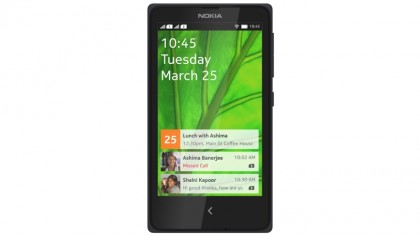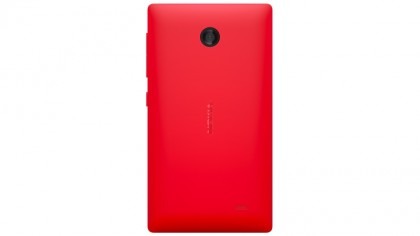TechRadar Verdict
A well built and designed budget smartphone that shows off some of the best of Nokia. It's let down by weak performance, but at the right price it's a strong offering despite an uncertain future.
Pros
- +
Strong build quality
- +
Low cost
- +
Dual SIM flexibility
Cons
- -
Weak performance
- -
Dim display
- -
Poor battery endurance
Why you can trust TechRadar
Ever since Nokia decided to go all-in with Windows Phone, there has been a nagging feeling that it would have been better off using Android as its mobile operating system of choice.
A feeling that has got stronger as Android devices have so rapidly taken over the lion's share of smartphone sales.
At Mobile Web Congress in February 2014, Nokia finally fulfilled this dream by announcing the Nokia X range comprising the Nokia X (reviewed here), a higher specified X+ and the physically larger Nokia XL. Not just one Android phone, but a whole range.
There was more than a little irony in seeing Stephen Elop, once a Microsoft stalwart and the architect of Nokia's Windows Phone strategy announcing these new devices on stage. He went to great pains to point out that the Nokia X is a phone running AOSP, the Android Open Source Project.
This project underpins every Android phone in the world. As always in the Nokia story, it is not quite as simple as that. While the Nokia X runs Android, it does not run Google Android.
Briefly, Android as we know it is typically made of two parts; the underlying Android system and the Google apps. The underlying Android system is what the Nokia X runs along with all the usual well known Android phones such as the Samsung Galaxy S range and the HTC One M8.
Unlike those devices though, the Nokia X does not run Google apps. In order to run Google apps – Gmail, Maps, Calendar, Google Now etc – phones need to be certified. Nokia has not taken this step and it has done so on purpose.
Sign up for breaking news, reviews, opinion, top tech deals, and more.

The Nokia X software is based off of Android 4.1, a version released in July 2012. There is so far no information on updates but we can only hope Android 4.4 is planned as that version is designed to run on lower end hardware.
Nokia has designed the X to use the equivalent services from itself and from Microsoft, and Nokia has provided an API for everything that Google provides meaning that developers should be able to port apps quite easily.
This makes the Nokia X an Android phone by name, but one that would perhaps be unfamiliar to those already used to running Android on other mainstream devices. If you are thinking of switching to the Nokia X from another Android device, it is most important to note that the Play Store is not available.

It is possible to side-load any legally obtainable apps including other app stores such as the Amazon app store, but even that wont bring Google services to the Nokia X.
Who would have imagined a Microsoft product running Android? It does seem like an anomaly, and by the looks of it that's exactly what the Nokia X will be - an anomaly.
Microsoft has announced that it will be ditching its Android plans altogether, leaving just four Nokia branded handsets running the heavily modified version of Google's platform - the X, X+, XL and X2.
Moving on from this muted outlook, what do you get on the Nokia X? The standout software included are Nokia HERE Maps, a fantastic alternative to Google apps, and Nokia MixRadio which is a great way to stream your favorite music on demand.
Instead of the Play Store you will find the Nokia Store, which is already starting to fill out with many top apps. Nokia include Facebook and Twitter apps along with BlackBerry Messenger as standard. Various simple games are loaded on the X as well. All these apps run on a heavily customised version of Android 4.1.

Powering the Nokia X is a dual-core Snapdragon S4 Play processor running at 1GHz with 512Mb of RAM and 4GB of internal storage, which can be supplemented by a microSD card. The X has a 4-inch WVGA (800 x 480) LCD display and a fixed focus 3MP camera on the back. There's no front facing shooter.
These are very modest specs indeed and that does end up informing the whole experience of using the Nokia X.
What makes up for that is the price, the range starts at just €89, £80 (around $120, AU$135). This is a phone targeted at emerging markets, at people who are buying their first smartphone and perhaps their first phone. Some buyers of the Nokia X will have never bought any sort of computing device before.
Nokia has brought the X range to Europe, including the UK, but it has been clearly designed to replace the top end of Nokia's Asha range of phones. The Asha range is filled with very nicely designed but slow and simple feature phones, which have very limited capabilities.

The Nokia X is a decent step up from an Asha device and has the potential to do a lot more. Here in the UK, other reasonable smartphones are available for a similar price as the X but in its first market, India, this is not the case. Phones at a similar price point suffer from extremely bad design and build quality and very poor performance.
Despite the meager specifications and just a 1500mAh battery, the Nokia X provides a reasonable upgrade for users in these emerging markets who are upgrading from either feature phones or locally produced budget handsets which simply will not have Nokia's level of design and build.
When you pull the rear shell off the Nokia X model it is possible to see another indicator as to the target markets for this new range. The Nokia X is a dual SIM device.
In many other markets, the best value for cellular connectivity is achieved by separating your contracts for voice usage and data usage, which mandates two SIM cards. It's like running your calls through Vodafone and your data through T-Mobile.

On the X, the dual SIM setup supports dual standby that means both SIM cards can be active at the same time. Only slot one supports 3G connections, so that is where you will want to put your data SIM. Both slots are of the micro SIM variety. There is no 4G in sight here, but that is hardly a surprise.
The X range comes in a lovely range of colours with the basic X is available in black, white, cyan, yellow, bright red and the bright green, which is especially striking. The slightly higher spec X+ shares the same palette while the larger XL swaps the red for an even nicer orange colour.
Nokia has done what Nokia always seems to do at the budget end of its range. It has designed and built a phone that looks and feels more expensive than it is, something Nokia do not get enough plaudits for.
